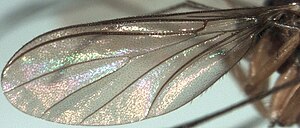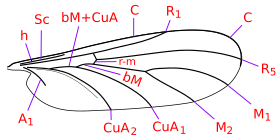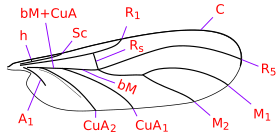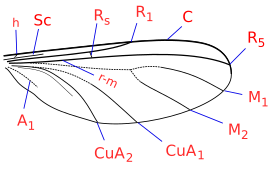Long-winged mushroom mosquitoes
| Long-winged mushroom mosquitoes | ||||||||||||
|---|---|---|---|---|---|---|---|---|---|---|---|---|

Wing veins of the genus Anisotricha |
||||||||||||
| Systematics | ||||||||||||
|
||||||||||||
| Scientific name | ||||||||||||
| Rangomaramidae | ||||||||||||
| Jaschof & Didham , 2002 |
The long-winged fungus gnats (Rangomaramidae) are a family described in 2002 in the superfamily of the Sciaroidea . They only occur in the southern hemisphere and on the Indian subcontinent.
features
The long-winged mushroom mosquitoes are small, brown to yellowish-brown mosquitoes 2 to 6 millimeters in length.
Their antennas are 16 sections. The compound eyes take up a relatively large part of the head. Most species also have three point eyes , but these can also be missing. The two lateral point eyes sitting near the compound eyes, but touch them not directly as with the equally to the mycetophilidae counting Mycetophilidae . The palps are four-limbed.
The long-winged fungus gnats differ from other families of gnats within the superfamily of the fungus gnats by two basic distinguishing features ( autapomorphies ). The laterotergites are fused with the mediotergite and the subcosta , a component of the wing veins , has two branches, with both branches opening into the costalader . The wing veins are reduced in the long-winged fungus mosquitoes, for example the basal part of the media and the fourth radial branch are missing. As with the gall midges (Cecidomyiidae), the spurs of the tibia are reduced.
distribution
The long-winged mushroom gnats of the genus Rangomarama are endemic to New Zealand . Other genera of the four subfamilies of the long-winged mushroom mosquitoes such as Heterotricha , Ohakunea and Insulatricha can only be found there. The other genera are native to South America, Africa and on the Indian subcontinent to Nepal . This speaks for an origin on the former southern continent Gondwana , which broke up around 150 million years ago. The few species in this family, which are very different from other mosquitoes, indicate a relic occurrence that developed in a geographically limited area for a long time.
Systematics
| Chiletrichinae |
| Rangomarama |
| Ohakuneinae |
| Comparison of the joint veins of three subfamilies of the long-winged mushroom mosquitoes . What they have in common is the reduction in veins compared to many other two-winged groups. C : Costalader ; Sc : subcosta ; R : radius ; M : median ; Cu : Cubitalader ; A : Anal veins . |
Internal system
Originally the family was set up for the only genus Rangomarama with 5 species. Later the New Zealand species Heterotricha novaezealandiae and Ohakunea bicolor , which were previously described in 1927 and could not previously be assigned to any family, were incorporated into the family of the long-winged fungus mosquito. The first descriptors of the two species, AL Tonnoir and FW Edwards, were honored in the species name of two Rangomarama species ( Rangomarama tonnoiri and Rangomarama edwardsi ). Because of their large deviations from Rangomarama , the genera Heterotricha and Ohakunea were each placed in their own subfamily within the family of the long-winged mushroom mosquito. At the same time, the subfamily Chiletrichinae was established, so four subfamilies are known:
- Subfamily Chiletrichinae
- Genus Chiletricha
- Genus Eratomyia
- Genus Insulatricha
- Genus Kenyatricha
- Genus Rhynchoheterotricha
- Subfamily Heterotrichinae
- Genus Heterotricha
- Subfamily Ohakuneinae
- Genus Cabamofa
- Genus Colonomyia
- Genus Ohakunea
- Genus Rogambara
- Subfamily Rangomaraminae
- The following genera are mostly classified in the subfamily Chiletrichinae, but there is still no final agreement:
- Genus Anisotricha
- Genus Nepaletricha
- Genus Madagotricha
External system
The family of the long-winged fungus mosquitoes were placed in the superfamily Sciaroidea within the suborder Bibionomorpha . They seem to be more closely related to the gall gnats (Cecidomyiidae), with which they could form the sister group of sciarid gnats (Sciaridae). A separate superfamily Cecidomyioidea for the gall mosquitoes, as has been proposed several times earlier, would thus be ruled out.
Individual evidence
- ↑ AL TONNOIR and FW Edwards: New Zealand fungus gnats (Diptera, Mycetophilidae). Transactions of the New Zealand Institute, 57, pp. 747-878, 1927
- ↑ Dalton De Souza Amorim and Eirik Rindal: Phylogeny of Mycetophiliformia, with proposal of the subfamilies Heterotrichinae, Ohakuneinae, and Chiletrichinae for the Rangomaramidae (Diptera, Bibionomorpha). Zootaxa, 1535, pp. 1-92, 2007
literature
- Mathias Jaschof & Raphael K. Didham: Rangomaramidae fam. nov. from New Zealand and implications for the phylogeny of the Sciaroidea (Diptera: Bibionomorpha). Studia dipterologia, Supplement 11, September 2002 ISBN 3-932795-16-4 (first description of the family)
- Mathias Jaschof: The Heterotricha group in New Zealand - (Diptera: Sciaroidea) . Contributions to Entomology, 54, pp. 3–30, 2004 PDF
- Dalton De Souza Amorim and Eirik Rindal: Phylogeny of Mycetophiliformia, with proposal of the subfamilies Heterotrichinae, Ohakuneinae, and Chiletrichinae for the Rangomaramidae (Diptera, Bibionomorpha). Zootaxa, 1535, pp. 1-92, 2007 PDF



